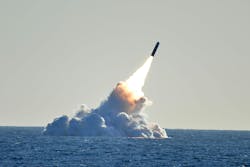Lockheed Martin to build additional submarine-launched nuclear ballistic missiles, guidance, and avionics
Summary points:
- Lockheed Martin secures a $647.1 million order to produce additional Trident II D5 submarine-launched nuclear missiles for the U.S. Navy and UK Royal Navy.
- The Trident II D5 missile features cutting-edge avionics, combining inertial and celestial navigation for precise targeting, with advanced flight control.
- Lockheed Martin is adapting the Trident II missile for deployment on the future Columbia-class and UK Dreadnought-class submarines, replacing older Ohio-class and Vanguard-class fleets.
WASHINGTON – Strategic weapons experts at Lockheed Martin Corp. will build additional UGM-133A Trident II D5 submarine-launched nuclear ballistic missiles in a $647.1 million order announced Tuesday -- the second multi-million-dollar Trident II missile within two months.
Officials of the U.S. Navy Strategic Systems Programs (SSP) office in Washington are asking the Lockheed Martin Space Systems segment in Titusville, Fla., to provide for Trident II (D5) missile production and deployed systems support. The missiles are for the U.S. Navy and United Kingdom Royal Navy.
The Trident II D5 is one of the most advanced long-range submarine-launched nuclear missiles in the world. It is the primary U.S. sea-based nuclear ballistic missile, and is deployed aboard U.S. Navy Ohio-class ballistic missile submarines. Lockheed Martin won a $110.9 million Trident II missile production order in August.
The U.S. Navy operates 14 Ohio-class ballistic missile submarines, each of which can carry as many as 24 Trident II missiles. Although the Trident II is designed to carry as many as 12 multiple independently targetable reentry vehicle (MIRV) warheads, current treaties reduce this number to four or five.
Flight-control avionics
The Trident II D5 missile's electronic subsystems include the major flight-control and missile guidance and avionics, with the Mk 6 navigation system, flight control electronics, and the post boost control system that maneuvers the missile in flight.
The guidance system combines inertial and celestial navigation, where the inertial measurement unit receives targeting data from the submarine, and celestial navigation updates the inertial system through star sightings during flight.
The missile uses four thrust vector control gas generators for flight control, and the flight control system manages plume avoidance to ensure accuracy when deploying the reentry vehicles.
The electronics section also integrates avionics for stage separation, ignition controls, and the arming of the warheads. The subsystems are designed with advanced composite materials for weight reduction and enhanced performance.
Tell me more about multiple independently targetable reentry vehicle (MIRV) warheads ...
- MIRV carries several nuclear warheads, each mounted in its own reentry vehicle and aimed at different targets after the boost phase. MIRVs let one missile hit several separate targets or overwhelm missile defenses by presenting many simultaneous threats. After boost stage, the missile maneuvers and sequentially releases individual reentry vehicles on trajectories to different targets. Re-entry vehicles also can deploy decoys and penetration aids to confuse missile-defense sensors. Missile defenses seek to detect and kill incoming warheads, but MIRVs combined with decoys raise interception difficulty.
Each Trident II missile has a range of 4,000 to 7,000 miles, and its navigation subsystem uses a combination of inertial and celestial guidance. The Trident II D5 was first deployed in 1990 and is scheduled to remain in service until at least 2027.
The Navy started the D5 Life Extension Program in 2002 to replace obsolete components using as many commercial off-the-shelf (COTS) parts as possible to keep costs down and to enhance the nuclear missile's capability. Draper Lab is in charge of upgrading the Trident II's guidance system, and has been working on this project since 2005.
In practice, the Trident II missile's inertial measurement system receives targeting data from computers aboard the submarine. The inertial measurement unit then transmits signals to the D5 flight-control computer and converts them into steering commands to keep the ballistic missile on target.
The missile's post-boost control system maneuvers the missile in flight to observe stars for the missile's celestial navigation subsystem, which updates the inertial system in flight.
Next-generation submarines
Lockheed Martin also is integrating the Trident II onto the next-generation ballistic missile submarine designs of the U.S. and United Kingdom by adapting the Trident II missile and reentry subsystems into the common missile compartment for the future Columbia-class missile submarine and United Kingdom Dreadnought class missile boats.
The Columbia-class ballistic missile submarine is being designed to replace the Navy's fleet of Ohio-class submarines. The future United Kingdom Dreadnought submarine, meanwhile, will replace the Royal Navy's fleet of Vanguard-class ballistic missile submarines.
The U.S. Navy today operates 18 Ohio-class submarines -- 14 of which carry the Trident nuclear missile. Four Ohio-class subs have been modified to carry conventionally armed long-range cruise missiles.
Ohio- and Vanguard-class submarines
The Ohio-class submarine has been in commission since 1981, and this class is scheduled to be decommissioned and replaced starting in 2029. The United Kingdom Vanguard-class ballistic missile submarine has been at sea since 1993. The Royal Navy operates four Vanguard-class subs.
On this order Lockheed Martin will do the work in Magna, Utah; Denver; Cape Canaveral and Titusville, Fla.; Kings Bay, Ga.; Bangor, Wash.; Culpepper, Va.; Sunnyvale, Calif.; Valley Forge, Pa.; Huntsville, Ala.; and other locations, and should be finished by September 2030.
For more information contact Lockheed Martin Space Systems online at https://www.lockheedmartin.com/en-us/products/trident-ii-d5-fleet-ballistic-missile.html, or the Navy Strategic Systems Programs office at https://www.ssp.navy.mil/.
About the Author
John Keller
Editor-in-Chief
John Keller is the Editor-in-Chief, Military & Aerospace Electronics Magazine--provides extensive coverage and analysis of enabling electronics and optoelectronic technologies in military, space and commercial aviation applications. John has been a member of the Military & Aerospace Electronics staff since 1989 and chief editor since 1995.
